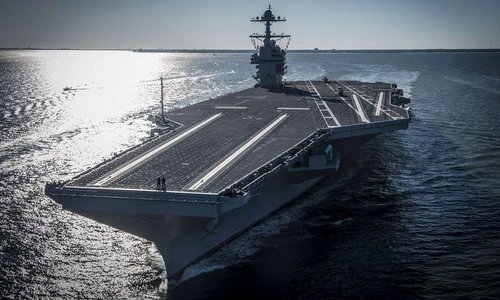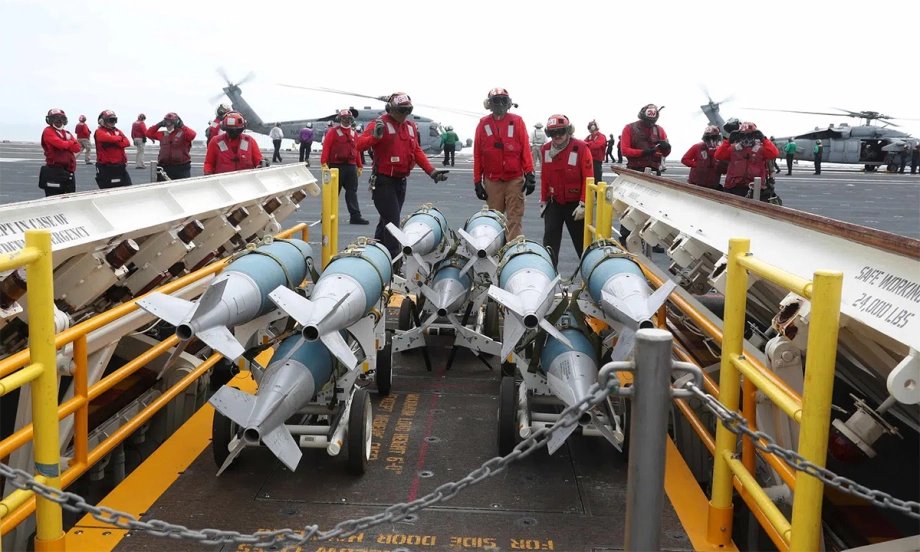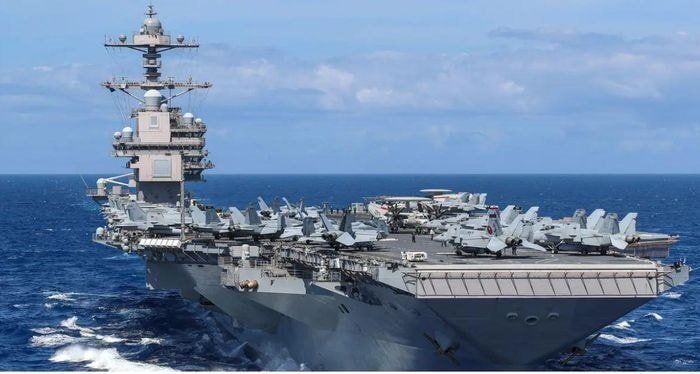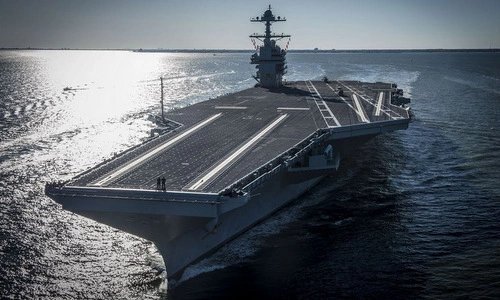The United States Navy has long been regarded as the pinnacle of maritime military strength, with its fleet of nuclear-powered aircraft carriers symbolizing unmatched power and global reach. Among these formidable assets, the next-generation Gerald R. Ford-class supercarriers were expected to revolutionize naval warfare with cutting-edge technologies and unprecedented capabilities. However, recent developments suggest that these massive warships may be falling behind schedule due to a series of technical failures—particularly involving critical systems such as aircraft elevators and electromagnetic catapults.
These issues have raised eyebrows among military analysts, defense contractors, and lawmakers alike, prompting questions about whether the U.S. Navy’s most expensive and technologically ambitious carrier program can meet its strategic goals. In this article, we delve into the details of the supercarrier’s setbacks, analyze their broader implications, and explore what lies ahead for the future of American naval supremacy.
### The Gerald R. Ford-Class Supercarrier: A Technological Marvel

The Gerald R. Ford-class represents the first major redesign of the U.S. Navy’s aircraft carriers in more than 40 years. Designed to eventually replace the aging Nimitz-class carriers, these supercarriers are intended to be more efficient, more powerful, and more advanced.
Key features of the Ford-class include:
– **Electromagnetic Aircraft Launch System (EMALS)** – A departure from traditional steam-powered catapults, EMALS promises smoother, more precise aircraft launches.
– **Advanced Weapons Elevators (AWEs)** – Designed to transport weapons and ammunition more quickly and safely from magazines to flight decks.
– **Increased Power Generation** – With two nuclear reactors generating over 100 megawatts of power, the ship is capable of supporting future technologies like directed energy weapons.
– **Reduced Crew Size** – Through automation, the carrier aims to reduce operational costs and manpower needs.
Yet, despite these innovations, it is the same advanced systems that now appear to be causing significant delays.
### Elevator Failures: A Costly Engineering Setback
Among the most publicized challenges facing the Ford-class carriers is the failure of the Advanced Weapons Elevators. These elevators are critical for ensuring rapid and efficient movement of munitions throughout the vessel. However, the integration of electromagnetic lifts into the ship’s architecture has proven more complex than anticipated.
Several issues have emerged:
– **Alignment Problems** – The precise calibration required for the elevators to operate seamlessly has caused repeated delays.
– **Software Glitches** – Automated control systems have suffered from inconsistencies and bugs, hampering reliability.
– **Safety Concerns** – The Navy has been unwilling to certify elevators that do not meet the highest safety standards, further prolonging the process.
As of the latest reports, not all 11 elevators on the USS Gerald R. Ford are operational—years after its initial delivery. This has undermined the carrier’s readiness and cast doubt on the viability of deploying future Ford-class ships on time.
### Catapult Failures: EMALS Under Scrutiny

Another major concern is the performance of the Electromagnetic Aircraft Launch System. While EMALS was meant to be a game-changer by replacing steam catapults, its implementation has been plagued by technical complications.
Among the most critical issues are:
– **Unreliable Launches** – Early tests showed inconsistent power levels during launches, sometimes damaging aircraft or failing to achieve proper liftoff.
– **High Maintenance Requirements** – The electromagnetic systems require constant monitoring and complex maintenance protocols, straining crew resources.
– **Software Integration** – Like the elevators, EMALS relies heavily on sophisticated software that has exhibited compatibility issues with other onboard systems.
These problems have not only delayed deployment schedules but have also raised strategic concerns about the carrier’s ability to sustain high-tempo operations during real-world combat scenarios.
### Impact on Delivery Timelines and Fleet Readiness
Delays in achieving full operational capability for the Ford-class carriers mean more than just missed deadlines—they could have a cascading effect on the Navy’s overall fleet readiness. As older Nimitz-class carriers approach decommissioning, the Ford-class is expected to fill the gap. Any failure to deliver them on time risks creating vulnerabilities in U.S. maritime defense.
Moreover, budgetary constraints could worsen. The USS Gerald R. Ford has already exceeded initial cost estimates by billions of dollars, and any additional time spent resolving technical issues only compounds the financial burden. According to recent Congressional reports, the cost overruns may necessitate shifts in other areas of military spending, potentially affecting broader defense priorities.
### Congressional Oversight and Industry Accountability

The persistent issues surrounding the Ford-class carriers have not gone unnoticed in Washington. Members of Congress have demanded greater transparency from the Navy and its contractors, primarily Huntington Ingalls Industries and General Atomics, which are responsible for key systems onboard.
Hearings have focused on:
– **Cost Overruns** – Lawmakers have questioned how initial projections could have underestimated the complexity of integrating new technologies.
– **Lack of Testing** – Some critics argue that the Navy pushed forward with production before adequately testing the systems involved.
– **Contractor Performance** – There have been calls for stronger accountability mechanisms for private defense contractors, including penalties for underperformance.
Despite these concerns, Navy officials remain optimistic, insisting that the lessons learned from the Gerald R. Ford will benefit future vessels in the class.
### Navy Response and Mitigation Efforts
In response to these setbacks, the U.S. Navy has launched several initiatives aimed at overcoming the technological challenges:
1. **Collaborative Problem-Solving** – Engineers from both the Navy and private industry are working around the clock to debug software and improve hardware performance.
2. **Phased Certification** – Rather than waiting for all systems to be fully operational, the Navy has begun certifying elevators and catapults individually to speed up deployment readiness.
3. **Training Enhancements** – New training modules have been developed for ship crews to better handle complex systems and troubleshoot on the fly.
While progress has been made, experts caution that achieving full operational status across all systems may still take several more years.
### The Strategic Importance of Carrier Readiness

The importance of getting the Ford-class carriers operational cannot be overstated. These ships are not just symbolic—they are critical components of American deterrence strategy in key regions such as the South China Sea, the Persian Gulf, and the North Atlantic.
In an era of renewed great power competition, especially with China rapidly expanding its own naval capabilities, any delay in deploying state-of-the-art U.S. supercarriers could embolden rivals and shift the balance of power.
### Looking Ahead: Can the Ford-Class Recover?
Despite its early troubles, the Ford-class still holds immense promise. The technology, once perfected, could usher in a new era of naval warfare defined by greater efficiency, more powerful weapons, and unprecedented levels of automation.
Several milestones offer hope:
– **Successful Aircraft Launches** – In recent months, the USS Gerald R. Ford has successfully launched and recovered various aircraft using EMALS and the Advanced Arresting Gear (AAG), showing improvement.
– **Deployment Trials** – The Navy plans to use the carrier for more extended trials and limited deployments to test its real-world performance.
– **Feedback Loops** – Lessons from the Ford are already being applied to the construction of subsequent carriers like the USS John F. Kennedy (CVN-79), potentially avoiding similar pitfalls.
Still, the road ahead is uncertain, and the Navy must walk a fine line between innovation and practicality.
### Conclusion: Innovation at a Crossroads
The delays plaguing the Gerald R. Ford-class supercarriers underscore the challenges of integrating cutting-edge technologies into mission-critical military hardware. While the promise of electromagnetic systems and automation is real, so too are the engineering, logistical, and operational hurdles that come with them.
For the United States Navy, the experience serves as a cautionary tale—but also a catalyst for change. If the problems can be resolved, the Ford-class may yet fulfill its destiny as a revolutionary force in naval warfare. If not, the program risks becoming a symbol of overambition, plagued by inefficiencies and lost strategic opportunities.
In the end, how the Navy handles these failures—and whether it can turn them into successes—will shape not only the future of American naval power but the broader dynamics of military innovation in the 21st century.
